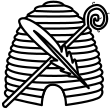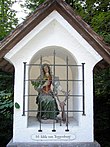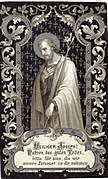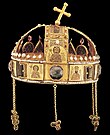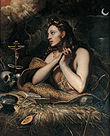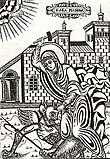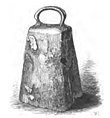| Article title
|
Attributes
|
| Máedóc of Ferns |
Honey bees [citation needed]
|
| Mary Magdalene |
jar of ointment, long hair, washing Christ's feet, skull, crucifix, red egg[a]
|
| Magdalene of Nagasaki |
Palm, Augustinian habit (without the typical nun hair net, since she was a lay sister), books[citation needed]
|
| Magnus Erlendsson, Earl of Orkney |
Viking clothing, axe[citation needed]
|
| Magnus of Anagni |
episcopal attire, martyr's palm[citation needed]
|
| Magnus of Cuneo |
depicted as a soldier bearing a banner and the martyr's palm[citation needed]
|
| Małgorzata Szewczyk |
Religious habit, rosary [citation needed]
|
| Malo (saint) |
Depicted as an abbot and a bishop[citation needed]
|
| Mamertinus of Auxerre |
depicted lying in his cell before his death[25]
|
| Mami Wata |
Snakes, pearls, gold, diamonds[citation needed]
|
| Mamilian of Palermo |
episcopal attire[citation needed]
|
| Mammes of Caesarea |
lion[citation needed]
|
| Manuel Aparici Navarro |
Priest's cassock [citation needed]
|
| Manuel Domingo y Sol |
Priest's cassock [citation needed]
|
| Manuel Lozano Garrido |
Newspaper, Rosary, Pen[citation needed]
|
| Manuel Míguez González |
Priest's attire [citation needed]
|
| Manuel Solórzano |
martyr's palm [citation needed]
|
| Manuela de Jesús Arias Espinosa |
Religious habit[citation needed]
|
| Marcantonio Durando |
Priest's cassock [citation needed]
|
| Marcellinus and Peter |
Depicted as two tonsured men holding crowns; martyr's palm; depicted alongside St. Pollio[32]
|
| Marcello Labor |
Priest's attire [citation needed]
|
| Marcian of Tortona |
martyr's palm[citation needed]
|
| Marciana of Mauretania |
represented with a leopard and bull near her[25]
|
| Marco da Montegallo |
Franciscan habit[citation needed]
|
| Marco d'Aviano |
Franciscan habit [citation needed]
|
| Marco Passionei |
Franciscan habit, crucifix, book[citation needed]
|
| Margaret of Castello |
a lily and a heart[25]
|
| Margaret of Hungary (saint) |
A lily and a book[25]
|
| Margaret of Scotland |
reading the bible[a]
|
| Margaret Pole, Countess of Salisbury |
martyr's palm, rosary, tunic bearing the Five Wounds of Christ [citation needed]
|
| Margaret the Virgin |
dragon, sometimes in chains, cross, hammer[a]
|
| Margareta Ebner |
Dominican habit[citation needed]
|
| Margaretha Flesch |
Religious habit[citation needed]
|
| Margarito Flores García |
palm[citation needed]
|
| Margherita Colonna |
Poor Clares habit[citation needed]
|
| Marguerite Bays |
rosary, Stigmata [citation needed]
|
| Marguerite Rutan |
Religious habit[citation needed]
|
| Maria Adeodata Pisani |
Benedictine habit, crucifix, bible[citation needed]
|
| Maria Angela Astorch |
Crosier, monstrance, breviary, Baby Jesus [citation needed]
|
| Maria Angela Picco |
Religious habit[citation needed]
|
| María Angélica Pérez |
Religious habit[citation needed]
|
| Maria Anna Donati |
Religious habit, crucifix [citation needed]
|
| Maria Anna Rosa Caiani |
Nun's habit[citation needed]
|
| Maria Anna Sala |
Religious habit[citation needed]
|
| María Antonia Bandrés Elósegui |
Religious habit[citation needed]
|
| María Antonia de Paz y Figueroa |
Religious habit, crucifix [citation needed]
|
| Maria Assunta Pallotta |
Religious habit[citation needed]
|
| Maria Bagnesi |
Dominican habit, crucifix, dagger[citation needed]
|
| Maria Bernarda Bütler |
Religious habit[citation needed]
|
| Maria Candida of the Eucharist |
Carmelite habit[citation needed]
|
| María Catalina Irigoyen Echegaray |
Religious habit[citation needed]
|
| Maria Caterina Troiani |
Nun's habit, crucifix [citation needed]
|
| Maria Clara of the Child Jesus |
Religious habit[citation needed]
|
| Maria Costanza Panas |
Franciscan habit [citation needed]
|
| Maria Cristina of the Immaculate Conception Brando |
Religious habit[citation needed]
|
| Maria Crocifissa Curcio |
Religious habit[citation needed]
|
| Maria Crocifissa di Rosa |
Religious habit[citation needed]
|
| María de la Purísima Salvat Romero |
Religious habit, rosary, Book of Hours[citation needed]
|
| María de las Maravillas de Jesús |
Discalced Carmelite habit, holding the rule of the order[citation needed]
|
| Maria De Mattias |
Foundress[clarification needed][citation needed]
|
| María del Carmen González-Ramos García-Prieto de Muñoz |
Religious habit[citation needed]
|
| María del Tránsito Cabanillas |
Religious habit[citation needed]
|
| Maria Domenica Brun Barbantini |
Religious habit[citation needed]
|
| Maria Domenica Mantovani |
Religious habit[citation needed]
|
| Maria Dulce Rodrigues dos Santos |
Nun's habit[citation needed]
|
| Maria Elisabetta Renzi |
Religious habit, crucifix [citation needed]
|
| María Emilia Riquelme y Zayas |
Religious habit[citation needed]
|
| María Francisca Ricart Olmos |
Religious habit[citation needed]
|
| Maria Gargani |
Religious habit[citation needed]
|
| Maria Giovanna Fasce |
Augustinian habit [citation needed]
|
| Maria Giuseppa Rossello |
Religious habit, book, lily[citation needed]
|
| Maria Goretti |
fourteen white lilies; humble clothing; (occasionally) a knife; martyr's palm[citation needed]
|
| Maria Grazia Tarallo |
Nun's habit, Scapular [citation needed]
|
| María Guadalupe García Zavala |
Religious habit[citation needed]
|
| María Guggiari Echeverría |
Discalced Carmelite habit [citation needed]
|
| Maria Hueber |
Religious habit[citation needed]
|
| Maria Josefa Alhama y Valera |
Religious habit[citation needed]
|
| Maria Josefa Karolina Brader |
Religious habit[citation needed]
|
| María Josefa Sancho de Guerra |
Book|Religious habit, Sash, rosary [citation needed]
|
| Maria Karłowska |
Religious habit[citation needed]
|
| Maria Katharina Kasper |
Religious habit, crucifix [citation needed]
|
| Maria Katherina Scherer |
Religious habit[citation needed]
|
| Maria Laura Mainetti |
Martyr's palm, rosary [citation needed]
|
| Maria Llorença Llong |
Religious habit[citation needed]
|
| María López de Rivas Martínez |
Nun's habit, crucifix [citation needed]
|
| Maria Maddalena Martinengo |
Nun's habit, crucifix, rosary, White flowers[citation needed]
|
| Maria Magdalena Jahn |
Religious habit, rosary, crucifix [citation needed]
|
| Blandine Merten |
Religious habit[citation needed]
|
| Maria Merkert |
Religious habit[citation needed]
|
| Maria Micaela Desmaisieres |
Religious habit[citation needed]
|
| María Natividad Venegas de la Torre |
Nun's habit, heart [citation needed]
|
| Maria Pia Mastena |
Religious habit[citation needed]
|
| María Pilar Izquierdo Albero |
Religious habit[citation needed]
|
| María Pilar López de Maturana Ortiz de Zárate |
Religious habit[citation needed]
|
| María Rafols Bruna |
Religious habit[citation needed]
|
| Maria Repetto |
Religious habit[citation needed]
|
| Maria Ripamonti |
Religious habit[citation needed]
|
| María Romero Meneses |
Religious habit[citation needed]
|
| Maria Schininà |
Religious habit[citation needed]
|
| Maria Scrilli |
crucifix, Carmelite habit [citation needed]
|
| Maria Soledad Torres y Acosta |
Religious habit[citation needed]
|
| Maria Teresa Casini |
Religious habit[citation needed]
|
| Maria Teresa Merlo |
Religious habit[citation needed]
|
| Maria Teresa of St. Joseph |
Religious habit[citation needed]
|
| Maria Therese von Wüllenweber |
Nun's habit[citation needed]
|
| Maria Theresia Bonzel |
Nun's habit[citation needed]
|
| Maria Troncatti |
Religious habit[citation needed]
|
| Maria Velotti |
Religious habit[citation needed]
|
| Maria Vicenta Rosal |
Religious habit[citation needed]
|
| Maria Vittoria De Fornari Strata |
Religious habit[citation needed]
|
| Mariam Baouardy |
Carmelite Nun's habit [citation needed]
|
| Mariam Thresia Chiramel |
Religious habit[citation needed]
|
| Mariam Vattalil |
Religious habit[citation needed]
|
| Mariana de Jesús de Paredes |
Lily, black cassock embroidered with the Christogram of IHS[citation needed]
|
| Mariana Navarro de Guevarra Romero |
Religious habit, Cross, Lily, Heart [citation needed]
|
| Marianna Fontanella |
Carmelite habit, crucifix, White flower[citation needed]
|
| Mariano Arciero |
Priest's attire, crucifix [citation needed]
|
| Mariano da Roccacasale |
Franciscan habit[citation needed]
|
| Mariano de Jesús Euse Hoyos |
Priest's cassock [citation needed]
|
| Mariano de la Mata |
Priest's attire[citation needed]
|
| Marie Anne Blondin |
Religious habit[citation needed]
|
| Marie Deluil-Martiny |
Religious habit of the Daughters of the Heart of Jesus, Sacred Heart
|
| Marie-Léonie Paradis |
religious habit of a Sister of the Holy Family, rosary, crucifix
|
| Marie of Oignies |
protected from rain by the Virgin Mary sheltering her with her mantle[citation needed]
|
| Marie of the Incarnation (Carmelite) |
Religious habit[citation needed]
|
| Marie of the Incarnation (Ursuline) |
Religious habit[citation needed]
|
| Marie-Alphonsine Danil Ghattas |
Religious habit, rosary [citation needed]
|
| Marie-Anne-Marcelle Mallet |
Religious habit[citation needed]
|
| Marie-Clémentine Anuarite Nengapeta |
Religious habit[citation needed]
|
| Marie-Élisabeth Turgeon |
Nun's habit, crucifix [citation needed]
|
| Marie-Eugène de l'Enfant-Jésus |
Carmelite habit[citation needed]
|
| Marie-Eugénie de Jésus |
Religious habit[citation needed]
|
| Marie-Geneviève Meunier |
Religious habit[citation needed]
|
| Marie-Madeleine Postel |
Religious habit, crucifix [citation needed]
|
| Marie-Marguerite d'Youville |
Religious habit[citation needed]
|
| Marie-Rosalie Cadron-Jetté |
Religious habit[citation needed]
|
| Marinus |
Depicted with a stonemason's hammer and tools; two oxen near him.[25]
|
| Mario Ciceri |
Priest's cassock [citation needed]
|
| Mark of Ephesus |
Long white beard, vested as a bishop, holding a scroll in one hand and Cross in the other[citation needed]
|
| Markella |
Martyr's palm, cross, scroll, (occasionally) being beheaded by her father.[citation needed]
|
| Marko Krizin |
Martyr's palm [citation needed]
|
| Marta Anna Wiecka |
Religious habit[citation needed]
|
| Martha |
broom, keys, tarasque,[33] aspergillum, dragon[a]
|
| Martial |
bishop raising the dead to life[25]
|
| Martin de Porres |
broom, a cat, dog and a mouse eating from the same plate[b]
|
| Martin of Tours |
geese; armament of a Roman soldier, sharing his cloak with a beggar[a]
|
| Martina of Rome |
palm of martyrdom[citation needed]
|
| Martyrs of Libya |
crown of martyrdom, orange jumpsuits, martyr's palm, crucifix[citation needed]
|
| Martyrs of Albania |
Palm [citation needed]
|
| Martyrs of Algeria |
Palm of martyrdom, Trappist habit [citation needed]
|
| Martyrs of Jasenovac |
Profession of faith, dove, martyr's palm, religious habit[citation needed]
|
| Martyrs of Laos |
Palm, Priest's cassock [citation needed]
|
| Martyrs of Natal |
Priest's attire, Palm branch [citation needed]
|
| Martyrs of Prague |
Franciscan habit, Palm branch [citation needed]
|
| Martyrs of the Spanish Civil War |
Crown of martyrdom, Martyr's palm, rosary [citation needed]
|
| Martyrs of Zenta |
Priest's cassock, Palm branch [citation needed]
|
| Mary de Cervellione |
Lily, boat, stormy sea[citation needed]
|
| Mary Elizabeth Lange |
Religious habit, rosary [citation needed]
|
| Mary Frances Schervier |
Religious habit[citation needed]
|
| Mary Magdalene |
Western: alabaster box of ointment; a skull on top of a book. Eastern: container of ointment (as a myrrhbearer), or holding a red egg (symbol of the resurrection); embracing the feet of Christ after the Resurrection [citation needed]
|
| Mary of Bethany |
Woman holding an alabaster jar of perfume (myrrh) and holding her hair[citation needed]
|
| Mary of Jesus de León y Delgado |
Dominican Religious habit, a rosary, the image of the Baby Jesus with laurel [citation needed]
|
| Massacre of the Innocents |
Martyr's palm, Crown of martyrdom [citation needed]
|
| Materiana |
crown; widow's robe.[citation needed]
|
| Maurus |
scales, spade, crutch[a]
|
| Menas of Crete |
two camels[a]
|
| Mercurius |
Martyr's palm[citation needed]
|
| Mateo Elías Nieves Castillo |
Cassock [citation needed]
|
| Matilda |
purse, alms[a]
|
| Matilde Salem |
brooch with the image of the Immaculate Conception [citation needed]
|
| Matteo Ricci |
Chinese Confucian scholar robes holding a crucifix and book [citation needed]
|
| Matthias the Apostle |
axe, Christian martyrdom [citation needed]
|
| Mattia Ciccarelli |
Augustinian habit, Eucharist [citation needed]
|
| Mattia de Nazarei |
Religious habit, book[citation needed]
|
| Maurice |
soldier in armour, soldier being executed with other soldiers, sub-saharan African in full armour, banner with red cross (the badge of the Order of Saints Maurice and Lazarus)[a]
|
| Maurice Tornay |
Augustinian habit [citation needed]
|
| Maurice-Marie-Matthieu Garrigou |
Cassock, Zucchetto [citation needed]
|
| Maurus of Parentium |
bishop holding the crown of martyrdom in his hand
|
| Maurus, Pantalemon and Sergius |
Mauro is represented in robes of a bishop with a book. Sergio and Pantaleone, in military attire, on a horse, while raising a flag with red cross on a white background[citation needed]
|
| Maximilian Kolbe |
Franciscan habit, the Rycerz Niepokalanej, Nazi concentration prison uniform, Nazi concentration camp badge, crucifix, rosary, and a palm of martyrdom [citation needed]
|
| Maximin of Trier |
depicted receiving Saint Athanasius at Trier; book; model of a church; bear at his side; commanding a bear to carry his things. [citation needed]
|
| Maximus of Turin |
depicted as a bishop pointing at a roe [citation needed]
|
| Mechtilde |
Scales and a sword, heart, book and dove[citation needed]
|
| Medardus |
Episcopal garments[citation needed]
|
| Meinrad of Einsiedeln |
two ravens[citation needed]
|
| Melchor Chyliński |
Franciscan habit[citation needed]
|
| Menas of Egypt |
Christian Martyrdom, man with his hands cut off and his eyes torn out; man with two camels; young knight with a halberd, an anachronistic depiction of his time in the Roman army [citation needed]
|
| Menina Izildinha |
Flowers[citation needed]
|
| Mercè Prat i Prat |
Teresian habit, Palm[citation needed]
|
| Michael (archangel) |
Archangel; treading on a dragon, carrying a banner, scales, sword, and weighing souls[a]
|
| Michael de Sanctis |
depicted kneeling before an altar where the Blessed Sacrament is exposed[citation needed]
|
| Michael Hồ Đình Hy |
Hanfu, Song official headwear, Martyr's palm, Dadao [citation needed]
|
| Michael J. McGivney |
Priest attire, Books, Rosary[citation needed]
|
| Michał Giedroyć |
crucifix [citation needed]
|
| Michał Sopoćko |
Cassock [citation needed]
|
| Michel Garicoïts |
Priest's attire [citation needed]
|
| Michele Carcano |
cross, skull [citation needed]
|
| Michelina of Pesaro |
Widow, pilgrim, and Franciscan tertiaries [citation needed]
|
| Miguel Febres Cordero |
Priest's cassock [citation needed]
|
| Miguel Pro |
Execution in a cruciform posture, Crown of martyrdom, Martyr's palm, rosary [citation needed]
|
| Mildrith |
Princess's crown, Abbess' crozier, hind [citation needed]
|
| Miliau |
depicted afs a cephalophore; in royal garb[citation needed]
|
| Minias of Florence |
Depicted as a young prince holding a crown; crowned with a rod and palm; crowned with a lily, rod and palm; carrying his severed head[c]
|
| Miroslav Bulešić |
Book, Palm, Priest's attire [citation needed]
|
| Modomnoc |
bees[citation needed]
|
| Monica |
girdle, tears[a]
|
| Monon |
Standing with a cow.[citation needed]
|
| Moses |
Tablets of the Law [citation needed]
|
| Mother Teresa |
Missionaries of Charity habit, rosary [citation needed]
|
| Moura |
Martyr's palm[citation needed]
|
 This article incorporates text from a publication now in the public domain: Herbermann, Charles, ed. (1913). "Symbolism". Catholic Encyclopedia. New York: Robert Appleton Company.
This article incorporates text from a publication now in the public domain: Herbermann, Charles, ed. (1913). "Symbolism". Catholic Encyclopedia. New York: Robert Appleton Company.
 This article incorporates text from this source, which is in the public domain.
This article incorporates text from this source, which is in the public domain.

